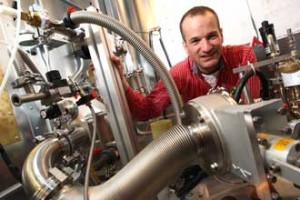
By Mark Shainblum
Dr. Guillaume Gervais’s laboratory in the basement of the Rutherford Physics building is a pretty extreme place: If your average, everyday research lab were, say, baseball, the Ultra-Low Temperature Condensed Matter Experiment Lab would be motocross racing or storm chasing.The lab boasts an atomic force microscope that can peer at objects as small as atoms and generate a magnetic field roughly half a million times more powerful than the Earth’s. It also has an ultra-low temperature apparatus designed to cool stuff down to 8 millidegrees Kelvin above absolute zero. That’s roughly 500 times colder than the temperature of the empty, starless space between galaxies.
“By cooling electrons or fluids to these extremely cold temperatures, we can get rid of thermal motion and actually study the fundamental laws that govern quantum particles,” Gervais explained. “And we know that at the nano scale, these are the laws that matter.”
What’s even more impressive is that Gervais and his grad students James Hedberg and Cory Dean built most of the high-tech laboratory gear themselves. “The atomic force microscope, which we created in collaboration with Peter Grütter, is a half-million dollar piece of equipment built for roughly $125,000,” Gervais said proudly.
That technical know-how has paid off in research results: Cory Dean is now a post-doctoral researcher at Columbia, while Gervais – along with post-doc Benjamin Piot – recently discovered an entirely new state of matter, a so-called “quasi-three-dimensional electron crystal” which was not predicted by the existing theory. Though still in the early stages, this breakthrough may have significant implications for quantum physics in general and the electronics field in particular.
But don’t get the idea Gervais only pushes electrons and electronic components around. He’s not afraid to get his hands dirty at the macro level when the situation calls for it. When he started his tenure at McGill in early 2005, Gervais and his grad students built not only the lab equipment, they essentially excavated and constructed the whole lab, an accomplishment Gervais credits to Martin Grant, who was then chair of the Physics Department and who is now Dean of Science.
“I told him we needed to start building right away, because we couldn’t do it once classes were under way,” says Gervais. “We built everything over the summer of 2005, and I was given the key to my laboratory the third week of September. Martin Grant and McGill gave me a huge push, which was critical. Otherwise I would have lost a year or two, and as we say in my super- competitive research community, if you take the time to eat lunch, you might become lunch. We were collecting good data within one year and half, rather than the two to three years it usually takes for low-temperature experiments. We were able to start competing with other research groups around the world in record time.”
You can see more photos of the Ultra-Low Temperature Condensed Matter Experiment Lab at www.physics.mcgill.ca/~hedbergj/labpage/home.htm
Star Labs is a new occasional feature putting the focus on cutting-edge labs and other research outposts at McGill. Know of a lab that deserves the Star treatment? Let us know at mark.shainblum@mcgill.ca.
